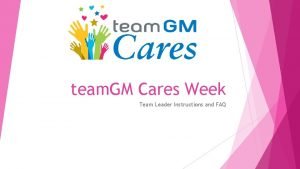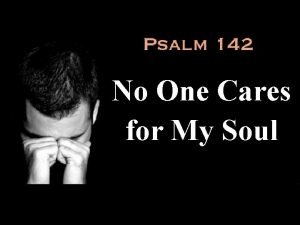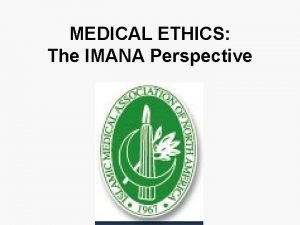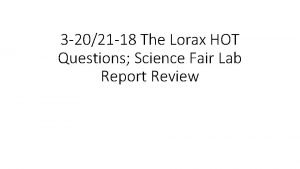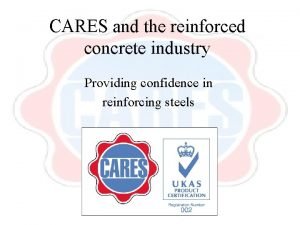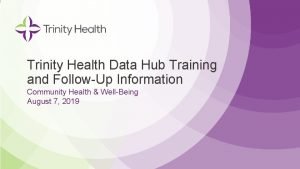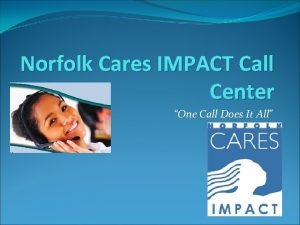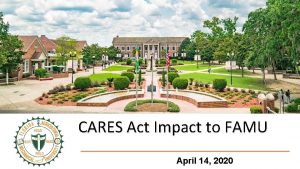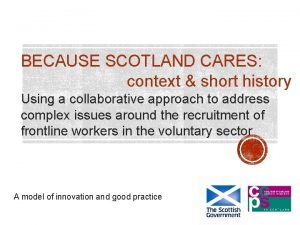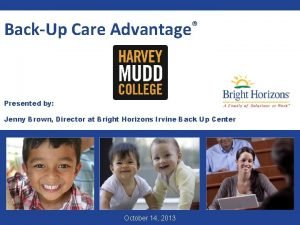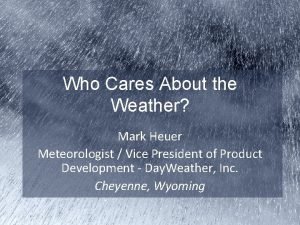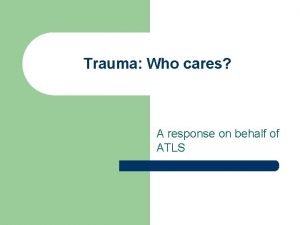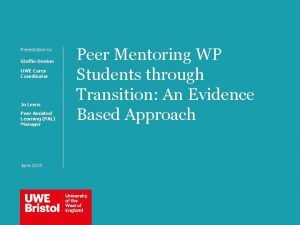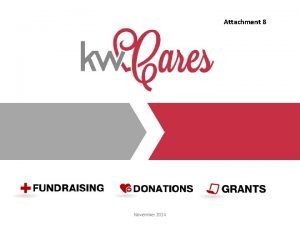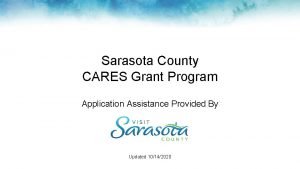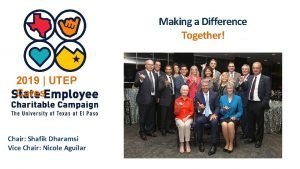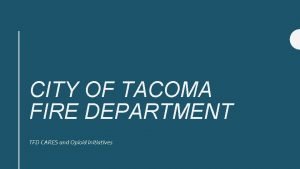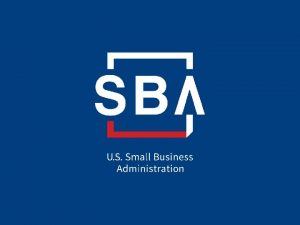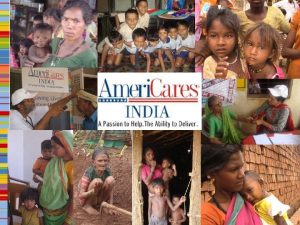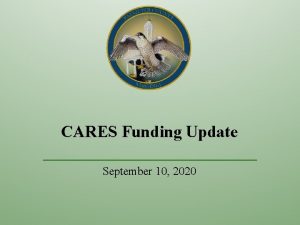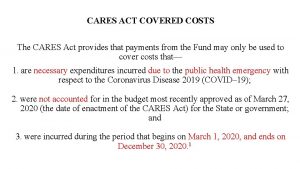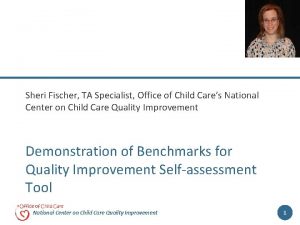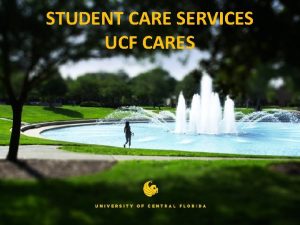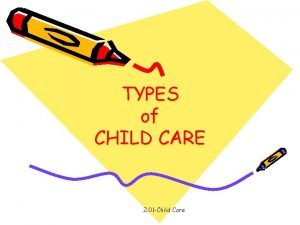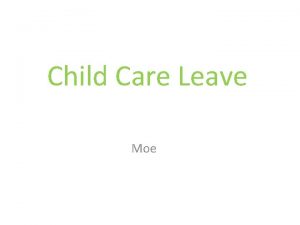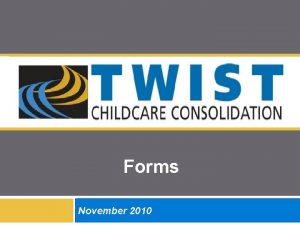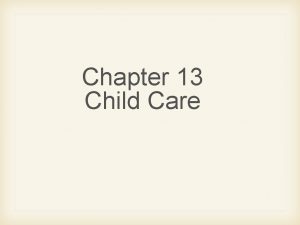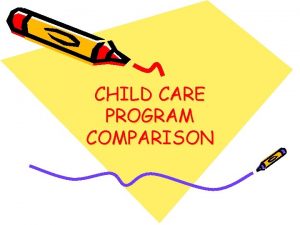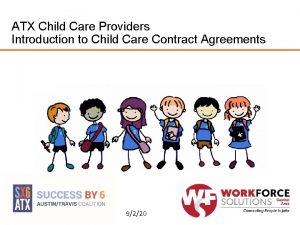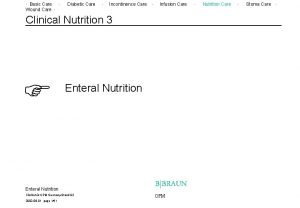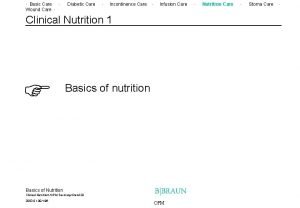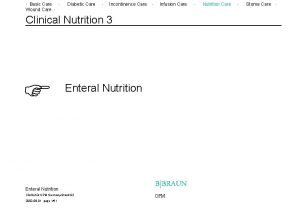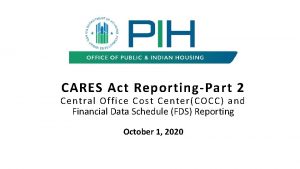The Office of Child Cares National Child Care

























































- Slides: 57

The Office of Child Care’s National Child Care Information and Technical Assistance Center Legal Foundations of Inclusion Institute May, 2011 This presentation provides information, not legal advice Presented by Abby J. Cohen, J. D. Region IX State TA Specialist

Agenda n Background n Laws, with an emphasis on ADA n Resources 2

Background Who Are the Children We Are Talking About? 3

Who and How Many Children Are We Talking About? n 11. 3 million children younger than the age of 5 are enrolled in some form of child care n 21. 8 percent of households have a child with a special health care need n Approximately 10. 2 million children younger than the age of 18 have a special health care need Sources: Fertility & Family Statistics Branch, Housing and Household Economic Statistics Division, U. S. Census Bureau. (2008). Who’s minding the kids? Child care arrangements: Spring 2005: Detailed tables. Retrieved March 9, 2009, from www. census. gov/population/www/socdemo/child/ppl-2005. html; Maternal and Child Heath Bureau, Health Resource and Services Administration, U. S. Department of Health and Human Services. (2008). The national survey of children with special health care needs, Chartbook 2005– 2006. Retrieved March 9, 2009, from http: //mchb. hrsa. gov/cshcn 05/NF/1 prevalence/individuals. htm 4

Who and How Many Children Are We Talking About (con. )? n A recent study found that approximately 13 percent of children in its sample had developmental delays, thus eligible for Individuals with Disabilities Education Act (IDEA) Part C services n For purposes of comparison, in 2002, Part C served 2. 2 percent of children younger than 3 Source: Rosenberg, S. A. , Zhang, D. , & Robinson, C. C. (2008, June). Prevalence of developmental delays and participation in early intervention services for young children. Pediatrics, 121(6). Retrieved March 9, 2009, from www. pediatrics. org/cgi/content/full/121/6/e 1503 5

Who and How Many Children Are We Talking About (con. )? n Head Start (HS), requires that at least 10 percent of children served be those with disabilities n Data show that in 2009, 12 percent of enrolled children had a disability, with 50 percent diagnosed before entering HS and 50 percent diagnosed during the program year Source: Center For Law and Social Policy. (2010, July). Head Start participants, programs, families, and staff in 2009. Retrieved May 10, 2011, from www. clasp. org/admin/site/publications/files/hs-preschool-pir-2009. pdf. 6

Laws Relevant to Inclusion in Child Care Settings Federal and State Laws Impacting Inclusion 7

Background n History of discrimination n Attitudes toward people with disabilities n Law both leads and follows n Recognizing benefits of inclusion; yet in all these laws no definition or term “inclusion” n See new joint statement on inclusion issued by NAEYC and DEC 8

Distinguishing Types of Laws n Enactment of laws to protect civil rights § Concern with discrimination by public accommodations § Concern with discrimination by publicly funded entities n Enactment of laws to provide services by entitlement 9

Primary Federal Laws n Civil rights laws § Section 504 of the Rehabilitation Act of 1973 applies to federally funded programs § The Americans with Disabilities Act (ADA) of 1990 and the ADA Amendments Act of 2008 provide equal rights to public accommodations 10

Primary Federal Laws, con. n Entitlements to services § IDEA of 1975 provides specified services by right to eligible persons with disabilities; reauthorized in 2004 11

ADA Structure n Prohibits discrimination in or by the following: Employment (Title I) State and local governments (Title II) Public accommodations (Title III) Public transportation (Title II[b] and Title III[b]) § Telecommunications (Title IV) § § 12

ADA Definition of Disability n A physical or mental impairment that substantially limits one or more major life activities n When determining whether a disability is present, mitigating or corrective measures are not taken into account (e. g. , medicine or prosthesis) 13

Major Life Activities n Federal law defines major life activities to include the following: § § § Walking Seeing Hearing Learning Taking care of oneself 14

ADA Protects Several Groups n Individuals with disabilities as defined by ADA n Individuals with a record of having disabilities n Individuals who are regarded as having disabilities n Individuals or entities associated with people with disabilities 15

Direct Threat: A Narrow Exception n Rarely, people with disabilities who pose a significant risk to others may be excluded if risk cannot be eliminated by modifications § Exclusion due to risk is an exceptional case; this is not the typical child who bites! 16

Public Accommodations n No public funding required; simply must be open to the public n Programs operated by religious organizations are exempt n Child care centers and family child care homes are covered n U. S. Territories must comply; Tribes cannot be sued by individuals, but can be sued by the Federal Government 17

When Programs Are Required to Admit a Child With a Disability Scenario: n A parent requests to enroll his/her child with a disability in a child care program n The program should evaluate the individual needs of the child with a disability n The program should follow the evaluation process to determine the child’s/program’s rights and responsibilities 18

Does the child’s condition pose a direct threat? Yes Can the direct threat be eliminated through reasonable modifications? No This child cannot be reasonably accommodated at this point. Reassess when the direct threat can be eliminated No Identify ways to reasonably accommodate the needs of the child. Yes Does the child need auxiliary aids and services to ensure effective communication? No Is this a new facility or are major renovations being made? No Do you need to reasonably modify policies, practices, and procedures to accommodate the child? Yes Do you need to remove any architectural barriers from an already existing facility to accommodate the child? Yes Will providing this impose an undue burden or fundamentally alter the nature of your program? No Will changing policies and practices fundamentally alter the nature of your program? Yes Are there any reasonable alternatives to accommodate the child? Yes Will removing barriers be readily achievable? No Yes Renovated area and new facilities (after 1/26/96) must be fully compliant with ADA Accessibility Guideline regulations No The child can be reasonably accommodated. Admit the child into your program. Yes No No Yes This child does not need to be accepted by your program now. If reasonably possible, set long-term 19 in goals to enable your program to meet similar needs the future.

What Must Providers Do? n Develop eligibility/admissions criteria that do not screen out or tend to screen out persons with disabilities n Make reasonable modifications to policies, practices, and procedures n Provide for equally effective communication n Comply with physical access requirements 20

Overarching Notion of Reasonable Accommodations n Examine program resources, tax credits and deductions (IRS Code Sections 44 and 190), and any available community resources n Provide individualized assessment n What is reasonable is based on conditions at a particular point in time, and this can change! 21

Eligibility/Admissions n Must eliminate all eligibility criteria that explicitly state children with disabilities cannot be included n Must eliminate admissions criteria such as “toilet trained, ” unless it is clear that this does not apply to children with disabilities n May impose legitimate safety requirements if necessary for safe operation 22

Eligibility: Charges n Providers may not impose a surcharge on a person with a disability to cover the costs of measures that are required under ADA n States are not precluded from paying more under ADA (in other words, there may be a special needs subsidy rate) 23

Modification of Policies, Practices, and Procedures n Providers are required to make reasonable modifications to policies, practices, and procedures unless the changes would fundamentally alter the nature of the program n If a modification would fundamentally alter the program, providers must determine if a reasonable alternative exists 24

Examples n Changing snack time or nap time n Eliminating a no-medication policy n Doing blood-prick testing n Providing visual cues of transitions n Assisting with the positioning of a leg brace n Allowing specialists to work with a child during program hours What examples do you have? 25

Fundamental Alteration n Very limited exception n Requires more than discomfort or inconvenience n Must “turn the program upside down” n Insulin injection may be a fundamental alteration 26

Medication Administration/ Health Procedures n Must administer medication if it is considered a reasonable accommodation (Alvarez v. Fountainhead, 55 F. Supp. 2 d. 1048, N. D. Cal. 1999) n Several States require specialized training in medication administration (e. g. , CO, CT, DE, NY, UT, WV, WY) n Settlements involving the U. S. Department of Justice (DOJ): Inhalers, Epi-Pens, and blood-prick testing n In CA: With conditions, insulin pumps, G-tube feeding, glucagon injections 27

Effective Communication n Ensure the provision of effective communication § Provide auxiliary aids and services § Not required if it would result in a fundamental alteration or undue burden (i. e. , a significant difficulty or expense) 28

Examples n Buying large print books n Learning sign language with an infant or toddler n Using picture cards 29

Removing Barriers to Physical Access n Three situations § Existing facilities § Major alterations/renovations to facilities § Newly constructed facilities 30

Existing Facilities n Buildings built or renovated before 1993 undertake “readily achievable” architectural modifications n Readily achievable means easily accomplishable and able to be carried out without much difficulty or expense 31

Examples n n Permanent or temporary ramps Grab bars in restrooms Wide doorways Furniture placement 32

Alterations n Alterations means changes that affect usability (i. e. , remodeling and renovation) n If made after 1992, the facility shall be made to ensure that, to maximum extent feasible, altered portions are readily accessible and usable; effectively follow ADA accessibility guidelines, with some distinctions 33

New Construction n Child care facilities built or major renovations made after January 26, 1993, must comply with the ADA Accessibility Guidelines n Guidelines for children’s environments and play areas have been developed under the authority of the Access Board; just recently adopted by the Department of Justice as regulations! 34

Access Guidelines n Extensive information about access guidelines is available at www. access-board. gov n Information includes play area guide and FAQs n See also: www. ada. gov/regs 2010/ADAregs 2010. htm 35

Enforcement n Law is enforced via private lawsuits or by the U. S. DOJ n DOJ can seek imposition of civil penalties up to $55, 000 for the first violation n DOJ has regularly enforced in child care; a recent settlement occurred against Nobel Learning Communities for failing to enroll and/or provide reasonable accommodations to preschool children with autism spectrum disorder and a brain shunt. 36

Title II(a) Provisions n Nondiscrimination in governmental/public body services, programs, and activities n Includes school district programs, park and recreation, etc. 37

Distinctive Provisions n “Qualified” individual with a disability: Must meet essential eligibility requirements for receipt of services n Someone who poses a direct threat is not qualified n A public entity may offer separate or special programs, but individuals with disabilities cannot be denied access to standard programs 38

Distinctive Provisions, con. n Must provide “program accessibility” unless to do so would create a fundamental alteration or undue financial or administrative burden; consider possible alternatives n Determination should be made by head of agency (with written findings) 39

Distinctive Provisions, con. n Must provide equally effective communication unless to do so would create a fundamental alteration or undue financial or administrative burden 40

Title II: Administration Requirements n Develop a grievance procedure n Designate a compliance officer n Conduct a self-evaluation n Provide information about Title II requirements to the public Enforced through the U. S. DOJ, Office of Civil Rights, Department of Health and Human Services, the U. S. Department of Education, or through Federal district court 41

Section 504 n Covers Federal Government executive agencies n Applies only to entities receiving Federal funds (the Child and Adult Care Food Program, the Child Care and Development Fund, HS, Title I pre-k, Part B Section 619, etc. ) n Similar protections to Title II of ADA n No religious exemption n States have no immunity from suit 42

State Law Equivalents n Determine if your state law parallels or provides greater protection than ADA or Section 504. 43

IDEA n Federal entitlement to services n These are responsibilities of the states/school districts, not private programs n Part B deals with children 3 to 21 years of age § Section 619 of Part B deals with children 3 to 5 years of age n Part C deals with infants and toddlers, birth to age 3 44

Part B n Children ages 3 to 5 who meet eligibility requirements are guaranteed a free appropriate public education (FAPE) n Services must be provided in the least restrictive environment (LRE), which includes child care settings 45

Eligibility n Mental retardation n Hearing impairment, including deafness n Speech or language impairment n Visual impairment, including blindness n Serious emotional disturbance n Orthopedic impairment n Autism 46

Eligibility, con. n n n Traumatic brain injury Other health impairment Specific learning disability Deafness/blindness Multiple disabilities … AND needs special education 47

Least Restrictive Environment (LRE) n Public agencies must ensure that to the maximum extent appropriate, children with disabilities. . . are educated with children who are nondisabled n Settings other than general education can only be used if the nature or severity of the disability is such that regular classes with the use of supplementary aids and services cannot be achieved satisfactorily 48

Individualized Education Program (IEP) n Children found eligible under Part B are entitled to have an IEP developed by a team including parents and professionals n This specifies the child’s special education, related services, supplementary aids and services, etc. 49

Individualized Education Program n Services will be provided to enable the child to participate with nondisabled children n An IEP must include an explanation of the extent, if any, to which the child will not participate with nondisabled children n In situations in which there is no public preschool, courts may find that the LRE is in a private preschool setting, especially where the IEP spells out a need for interaction with typically developing peers. 50

Part C n Eligibility includes the following: § Children with developmental delays § Has a diagnosed physical or mental condition that has a high probability of resulting in developmental delay; § At state option, children at risk of having substantial developmental delays 51

Natural Environments n To the maximum extent appropriate to the needs of the child, early intervention services must be provided in natural environments n Includes a child’s home n “Community settings in which children without disabilities participate, ” such as child care n Natural environments means settings that are natural or normal for the child’s age peers who have no disabilities 52

Natural Environments (con. ) n Settings other than natural environments can only be used if early intervention cannot be achieved satisfactorily for the infant or toddler n It is presumed that services will be offered in natural environments because if they are not, a justification must be provided. 53

Individualized Family Services Plan (IFSP) n Children eligible under Part C are entitled to an IFSP developed by the IFSP team which includes parents and professionals n Early intervention services necessary to meet the outcomes are detailed n Each IFSP must include a statement of the natural environments in which the services will be provided and a justification of the extent, if any, to which the services will not be provided in a natural environment 54

Resources n Access Board, www. access-board. gov n ADA homepage, U. S. DOJ, www. usdoj. gov/crt/adahom 1. htm; www. ada. gov/regs 2010/ADAregs 2010. h tm 55

Resources, con. n Center on the Social and Emotional Foundations for Early Learning, http: //csefel. uiuc. edu n Child Care Plus+: The Center on Inclusion in Early Childhood, www. ccplus. org n Center for Inclusive Child Care, www. inclusivechildcare. org n Education Law Center, www. edlawcenter. org n National Early Childhood Technical Assistance Center, www. nectac. org n Special Quest, www. specialquest. org 56

Thank You NCCIC does not endorse any non-Federal organization, publication, or resource. Prepared by NCCIC Phone: 800 -616 -2242 ● Fax: 800 -716 -2242 Email: info@nccic. org ● Web: http: //nccic. acf. hhs. gov 57
 Primary care secondary care tertiary care
Primary care secondary care tertiary care Gm cares
Gm cares No one care
No one care Is imana cares fake
Is imana cares fake If someone like you cares a whole awful lot
If someone like you cares a whole awful lot Cares rebar
Cares rebar Cares engagement network
Cares engagement network The lord cares
The lord cares Norfolk cares
Norfolk cares No one cares for my soul
No one cares for my soul Famu cares act
Famu cares act Because scotland cares
Because scotland cares Backup care advantage
Backup care advantage Does jesus care when my heart is pained
Does jesus care when my heart is pained Who cares about the weather
Who cares about the weather Trauma who cares
Trauma who cares Uwe pal
Uwe pal Kw cares application
Kw cares application Be not entangled with the cares of this world
Be not entangled with the cares of this world Sarasota county cares grant
Sarasota county cares grant Utep cares
Utep cares Fire extinguisher service tacoma
Fire extinguisher service tacoma Hát kết hợp bộ gõ cơ thể
Hát kết hợp bộ gõ cơ thể Bổ thể
Bổ thể Tỉ lệ cơ thể trẻ em
Tỉ lệ cơ thể trẻ em Chó sói
Chó sói Tư thế worm breton
Tư thế worm breton Hát lên người ơi
Hát lên người ơi Môn thể thao bắt đầu bằng từ đua
Môn thể thao bắt đầu bằng từ đua Thế nào là hệ số cao nhất
Thế nào là hệ số cao nhất Các châu lục và đại dương trên thế giới
Các châu lục và đại dương trên thế giới Công thức tiính động năng
Công thức tiính động năng Trời xanh đây là của chúng ta thể thơ
Trời xanh đây là của chúng ta thể thơ Mật thư tọa độ 5x5
Mật thư tọa độ 5x5 Làm thế nào để 102-1=99
Làm thế nào để 102-1=99 độ dài liên kết
độ dài liên kết Các châu lục và đại dương trên thế giới
Các châu lục và đại dương trên thế giới Thơ thất ngôn tứ tuyệt đường luật
Thơ thất ngôn tứ tuyệt đường luật Quá trình desamine hóa có thể tạo ra
Quá trình desamine hóa có thể tạo ra Một số thể thơ truyền thống
Một số thể thơ truyền thống Cái miệng bé xinh thế chỉ nói điều hay thôi
Cái miệng bé xinh thế chỉ nói điều hay thôi Vẽ hình chiếu vuông góc của vật thể sau
Vẽ hình chiếu vuông góc của vật thể sau Thế nào là sự mỏi cơ
Thế nào là sự mỏi cơ đặc điểm cơ thể của người tối cổ
đặc điểm cơ thể của người tối cổ Thứ tự các dấu thăng giáng ở hóa biểu
Thứ tự các dấu thăng giáng ở hóa biểu Vẽ hình chiếu đứng bằng cạnh của vật thể
Vẽ hình chiếu đứng bằng cạnh của vật thể Tia chieu sa te
Tia chieu sa te Thẻ vin
Thẻ vin đại từ thay thế
đại từ thay thế điện thế nghỉ
điện thế nghỉ Tư thế ngồi viết
Tư thế ngồi viết Diễn thế sinh thái là
Diễn thế sinh thái là Các loại đột biến cấu trúc nhiễm sắc thể
Các loại đột biến cấu trúc nhiễm sắc thể So nguyen to
So nguyen to Tư thế ngồi viết
Tư thế ngồi viết Lời thề hippocrates
Lời thề hippocrates Thiếu nhi thế giới liên hoan
Thiếu nhi thế giới liên hoan

